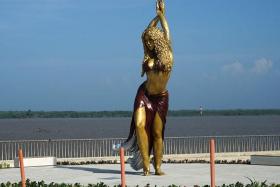There's more to Colombia than Narcos
South American country in hit Netflix show about drug trafficking is tired of being known for its past
"What do people in Colombia think of Narcos?"
It was an inevitable question, even more so from a group such as ours - international media who had flown into the country's capital, Bogota, for a Narcos press trip in August, courtesy of Netflix.
For most of us, fresh off binge-watching the crime drama in preparation for interviews with the cast members of its third season, the side of Colombia we have seen is its dark and drug-tainted history as depicted in the show.
Narcos is based on the real-life drug trade in Colombia between the 70s and 90s, with the first two seasons focusing on the most notorious of cocaine kingpins - Medellin drug lord Pablo Escobar.
Season three introduces the Cali Cartel, which rose in power after Escobar's death in 1993.
Our local guide Nicole, 25, who saw the question coming, stressed that there is so much more to her beloved country than its infamous cocaine trade of the past.
She said: "Most Colombians are done with the same story, over and over again. You have to recognise that Escobar and drug trafficking was part of the story, but we are building another story."
As she led us on a tour around Bogota's vibrant old town, La Candelaria, she spoke passionately of its people, culture and food.
La Candelaria was the perfect starting ground to soak it in, with its mix of traditional Spanish and art deco architecture, graffiti-decorated buildings and more.
Most Colombians are done with the same story, over and over again... we are building another story.Local guide Nicole, who is tired of Colombia being constantly associated with the drug trade
Graffiti, Nicole said, became popular in Bogota three years ago as an expression of political and social criticism. It comes in all colours and forms, and each creation usually tells a story.
One shows a soldier missing a leg, using a gun as a cane - a reference to Colombia's long-running conflict between the government, rebel group Revolutionary Armed Forces of Colombia and right-wing paramilitaries, which has resulted in the deaths of hundreds of thousands.
Our day out in Bogota also introduced us to three other things Colombia is famous for - food, coffee and the majestic Monserrate.
CAFE CULTOR
The folks at Cafe Cultor are passionate about coffee, and it shows.
They work hand-in-hand with the farmers who produce the coffee beans, not only buying the beans but helping the farmers improve their methods and teaching them about responsible farming.
We visited the branch at the Luis Angel Arango Library, where we learnt more about the differences in coffee from three regions in Colombia - Tolima, Huila and Narino.
MONSERRATE
Want a bird's-eye view of the sprawling city of Bogota? Take a cable car or funicular or trek up the mountain.
Pilgrims walk up to the sanctuary at the summit - located 3,152m above sea level - to offer prayers and seek peace and clarity.
ANDRES CARNE DE RES
Pro tip: Do not forget your dancing shoes if you are dining here. One minute you are tucking into ceviches and empanadas, the next you are whisked off to the dance floor, showing off your salsa moves.
Andres Carne de Res is far from your typical restaurant, boasting an outrageous interior decor and an electric party atmosphere.
One article described it as "Alice In Wonderland meets Moulin Rouge", and it is not far from the truth. Be sure to make reservations.
Get The New Paper on your phone with the free TNP app. Download from the Apple App Store or Google Play Store now




